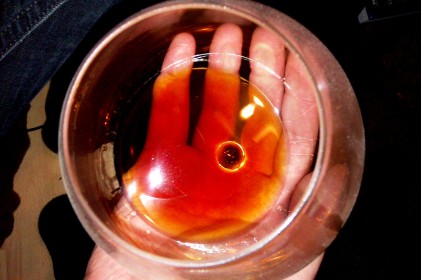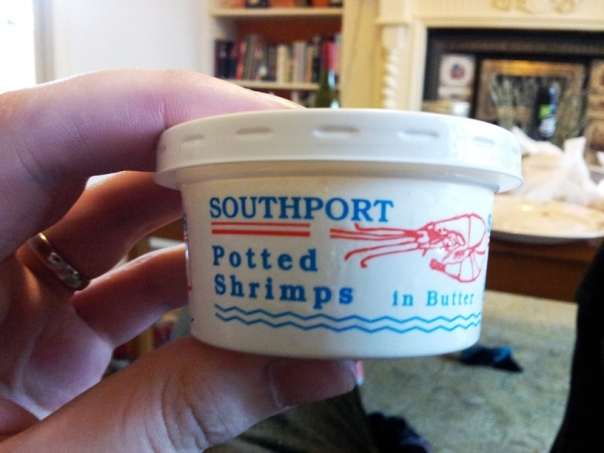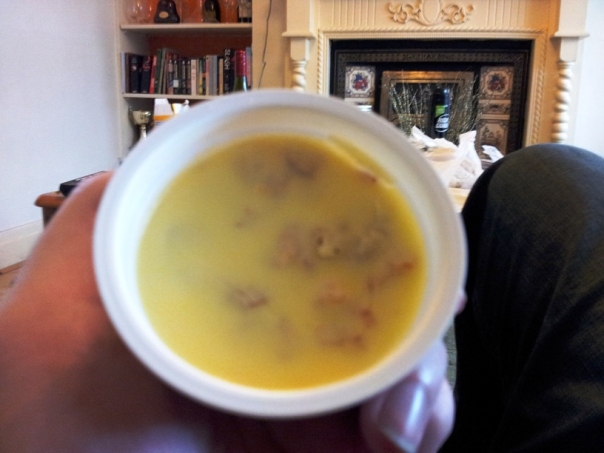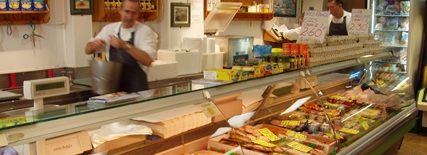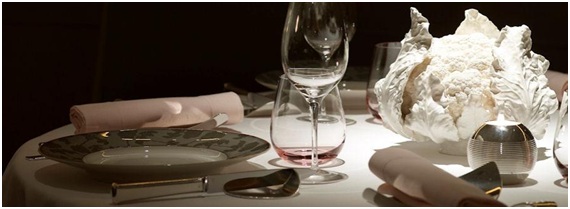Monthly Archives: November 2011
Hennessy XO Cognac
Traditionally, I haven’t thought much about money when it comes to food and drink; or at least, not as much as I should given what’s left once the bills have been paid. My chief focus has always been whether the thing I’m consuming tastes good or not. The cost is very much a secondary concern.
I couldn’t tell you how much I spent on my meal at The Waterside Inn – a restaurant generally considered to be ludicrously expensive – earlier this year. I couldn’t say how much I spent at Alain Ducasse at The Dorchester – a place very much in the same price mould – either. The reason is that I simply don’t care. I had a great time at both, so however much they cost, it was clearly worth it.*
Nevertheless, in the last few months value for money is something I’ve been thinking about more often. The change in mindset, I’m sure, is almost entirely down to working my way through the Foods To Try Before You Die list.
Tasting a £50 bottle of Dom Pérignon 2000, for example, I couldn’t get its value out of my head. It wasn’t so much “have I made a mistake spending this amount on a bottle of champagne?”, more “is this bottle worth the £100+ a lot of retailers are selling it at and is the price I got it for the bargain it appears?”.
Money was a big thing again when I wrote my latest piece on potted shrimp. It was so good yet so cheap relative to almost everything else on my list, how could I not think about it? Am I wasting cash pursuing expensive items when there are simple things like shrimp that offer so much bang for my buck?
But I’ve never thought so much about the cost of food or drink as I have with the bottle of Hennessy XO Cognac I bought a few months back. At £92, it was easily the most I’ve ever spent on a single bottle of alcohol outside a restaurant, and I wasn’t even a big brandy fan! From the moment I bought it, right up until the moment I poured my first glass, “what the hell were you thinking?” ran through my head.
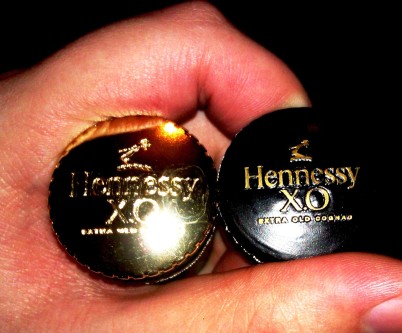
For anybody concerned about my health, those yellow spots are down to autocorrect lighting, not liver failure.
This wasn’t a case of ‘taste first, ask money questions later’; the price was always at the forefront of my mind. The cognac couldn’t just be good, it had to be at least £92 good, or I was going to kick my arse down to the bank to shed tears over all the money I’d pissed up the wall.
To be fair to Hennessy, they did a lot to put my mind at ease just with the appearance of the bottle. I’d read a lot of reviews online and been told it was a very special drink – the finest XO in its price range, according to consensus – but it wasn’t much of a looker. In photos it appeared plain and dull; a £20 slut instead of a £92 beauty.
But I spent a good 15 minutes marvelling at its magnificence after pulling it from the box; holding it up to the light and admiring it from every angle. The pictures had done scant justice to how handsome the bottle is, with the glorious maple-syrup-coloured liquid inside. I could imagine it behind the bar of a stereotypical private gentleman’s club, where well-to-do toffs sit in cosy, red-leather armchairs, puffing cigars and discussing the politics of the day.
It looked expensive enough to have cost £92. In fact, it could’ve pulled off £250. It was all very reassuring.
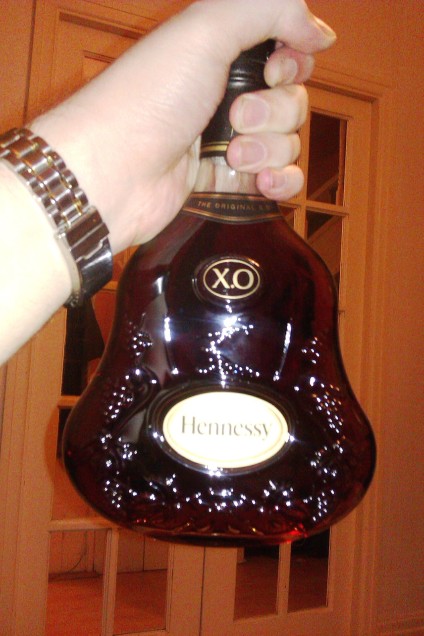
My shoddy camera phone isn't doing it any favours here, but take my word for it - the Hennessy XO bottle is a stunner.
But as I left it on the shelf and waited for that special occasion to come along where I’d give it a try – my birthday, as it happened – doubts started to creep back in. Sure, it looks good enough, but can it taste good enough? They say with wine once you go beyond £20, prices tend to move further and further away from the true value – is it the same with cognac? And what if I realise that I’m just not a big fan of brandy? Money down the drain, that’s what!
I decided the time to bite the bullet was after a nice celebratory meal at The Lime Tree in Didsbury. I was in a good mood, I wanted a spirit to cap off the evening, the moment just seemed right. Following instructions read online, I poured a shot and a half into a brandy glass** and cupped my hands around it, allowing my body heat to warm it gently for around seven or eight minutes. I held it up to look at the colour – the liquid amber perhaps even more beautiful in the glass than in the bottle – and then stuck my nose in to gather the aromas.
I probably shoved my snout too close because all I got was burning alcohol at first, but eventually the bouquet came: heady, complex, brilliant. I’ve heard people say they’d buy Hennessy XO for the smell alone and I could see why. If I’d had the time, I could’ve spent as long sniffing it as I did staring at the bottle when I first took it out of the box.
However, I couldn’t wait that long. It was time to taste it; time to find out whether all the build up was worth it. More importantly, it was time to find out whether all the money was worth it.
It was. Oh dear god it was.
Ambrosia, soma, nectar; any deity’s drink you can think of would be a suitable descriptive term for the glorious elixir that passed my lips. In my heart, I hadn’t really believed that any drink could justify this sort of price tag, but it did, unquestionably. It was a seminal moment; with one sip, I became a huge brandy fan and began to realise just how good beverages can be. I’ve imbibed some very nice stuff in my time, but this was a world apart. It’s by far and away the best drink I’ve ever tasted.***
Hennessy XO wasn’t on my list of Foods To Try Before You Die, but I feel like it should’ve been. The only cognac on there is the £1,350 Rémy Martin Louis XIII and even though it’s meant to be the very best, somehow I can’t see it living up to its price.
To do so, it’d have to be 14.5 times better than the Hennessy XO. And I don’t for one second believe that’s possible.
——————————
*I should stress that had either of these restaurants delivered a terrible meal then I’d probably still be bitching and whining about the cost on my deathbed. I care a lot more about price when I have a bad time!
**I fear connoisseurs would complain about the large balloon glass, with its wide mouth – snifters are preferred as they hold the aroma in. But the glasses were a wedding gift, gorgeous LSA glassware that match our collection, and they’d spent a good month sat next to the cognac helping it to look pretty. It would’ve felt wrong to drink from anything else.
***I’ve said before I don’t really do tasting notes. But these from the manufacturer seem right on the money:
Aroma: The first wave, rich in dried fruit aromas such as prunes or dried figs overcomes you. The aromas evolve to more dense notes of chocolate & black pepper, mellowed by cinnamon, clove & cardamom spices.
Taste: Very balanced on the palate, X.O confirms the aromas discovered by scent: dried fruit & chocolate. Elegant & robust, it reveals balance, roundness and harmony among aromas underlined by the strength of peppery notes & vegetable fragrances from the oak. A lovely long after taste is enrobed in velvet, conferring the last sweet notes of cinnamon & vanilla.
Food #8: Potted shrimp
There are some items on my list of Foods To Try Before You Die that you might be able to term ‘extravagant’. If for example I decided now was the time to taste golden Iranian almas caviar, the rarest and finest sturgeon eggs on the planet, it would cost me approximately £1,200. That princely sum would buy me a whopping 50g of the stuff.
If I decided I wanted to get a bottle of Rémy Martin Louis XIII Cognac instead, I’d need to go back to my savings account and pull out a further £150. While you’re busy working out how much money you’d be pouring down your throat every time you have a snifter,* think about how far that £1,350 would get me in the world of Domaine de la Romanée-Conti.
With some bottles I wouldn’t even be able to afford a glass!
Then of course there’s the ortolan bunting, which I might be even less likely to try than the caviar or the DRC. How much that would cost, I have no idea, because it’s a protected species and I believe it’s illegal to catch, kill and sell it. I’d need to have a dodgy contact in France and be prepared to hide my shame from God to try that one.**
It’s perhaps a little bit over the top.
But at the other end of The List, a mile away from the lavish showbiz lifestyle that the above-mentioned items enjoy, lies the humble potted shrimp; a food that you might be able to term ‘how the hell have you never eaten it before?’. £1,350 would buy me about 1,000 small tubs from my local fishmongers.
It took just one taste to tell me that, relatively, it’s a helluva bargain.
I never really thought it’d be possible to improve on your bog-standard buttered toast. Jam, marmalade and even honey are all worthy additional spreads that I sometimes use to inject variety into my life, but they just make the toast different, not better. Marmite does nothing for me, chocolate spread is vile. Peanut butter looks like shit and smells like a yeast infection, and tastes like a combination of the two.
But somehow these little squidgy morsels of preserved shellfish,*** together with a healthy dose of mace, managed to succeed where all other toast toppers have failed. It took the already perfect buttery toast to new heights.
It was subtly done. The brown shrimp added a flavour of fish, as you’d expect, but the spice kept it in check and provided balance; there was never any danger of either component dominating the dish.
The meaty texture was a little more overt – its prawn-like consistency the ideal complement to the crisp toast – but even that wasn’t overly prominent. The whole thing was at one with the butter; I didn’t feel as if any additions had been made. It was like this was the way the butter had always been and always should be.
It was rather wonderful and very moreish. My wife and I quickly ran through one tub and ran to defrost another. Our new toaster was used more times in the space of an hour than in the entire rest of its existence. The jar of foie gras de canard entier we bought for £21 on the same shopping trip sat forgotten on the side.
The whole thing was just joyous; food to put a big smile on your face. Nothing fancy, nothing pretentious, just good honest grub – cheap, delicious and diet-altering. Jam won’t get a look in ever again.
It’s still early days in my journey through The List. Already, I’ve had some incredible experiences, some disappointing ones, and others that fall somewhere in between. Given their respective costs, it’s probably not surprising that each was more interesting in terms of taste and appearance than the dish I’ve been talking about here.
But, as they say, often the simple things in life are the best. When it comes down to pure pleasure, potted shrimp’s right up there with the very finest.
Verdict: Highest possible recommendation
NEXT UP: Confit de canard
——————————
*Very roughly, if you pour conservatively, you’d be talking about £75 per drink of cognac.
**If you can stomach Jeremy Clarkson, this video will explain all things ortolan: http://www.youtube.com/watch?v=8y4MS7mSzX8
***The shrimp was from Southport, I should point out (although you can probably see that from the pictures). I’d obviously been hoping for the Morecambe Bay variety, but I can’t imagine there’s much difference between the two (if there is, let me know!). My thinking is, as long as it’s from the good old North West, it doesn’t really matter.
Restaurant Review: Damson
On paper, Heaton Moor’s Damson should deliver one of the best Sunday lunches in Manchester.
The first thing going for it is it’s a bloody good restaurant. I’ve had four evening meals there since it opened in 2009 and can’t recall it hitting a single bum note. In my experience, it offers a consistency unmatched by any other restaurant in the city on a Saturday night. The food, the service and the ambiance have been uniformly excellent every single time.*
The second big reason it should rock on a Sunday is that revered restaurateur Steve Pilling is in charge; the man who built his reputation at Sam’s Chop House with its peerless beef roast. I visited the Chapel Walks pub regularly to eat this dish during his tenure and it remains the best non-home-cooked roast I’ve ever had.
Sadly, Sunday lunch at Damson does little to live up to the standards set by the restaurant on other days of the week, or Mr Pilling’s illustrious past.**
A starter of chicken liver and foie gras parfait, rhubarb chutney and toasted ginger brioche wasn’t bad, just mildly irritating. While all well made, the generous parfait slab dwarfed the two small pieces of brioche and thimble’s worth of chutney served alongside it.
Even rationing myself to an enormous chunk of parfait and tiny nibbles of brioche and chutney per bite – not the easiest balancing act, and an overly rich one – I still managed to exhaust the accompaniments with more than a quarter of the paté left.
Fortunately by this stage my wife was tired of her “too dry” game terrine and was able to provide me with some toast reinforcements.
Real problems, as opposed to minor quibbles, appeared with the main: 21 day aged roast rib of Cheshire beef served with Yorkshire pudding, duck fat roasted potatoes, seasonal vegetables and roasting juices.
My beef – seemingly cut from the end of the joint – was brown, not pink as requested. The plate was cold. What I imagine was meant to be the roasting juices was merely a damp stain that appeared to have been wiped around a bit. “Wouldn’t you think they’d give us a gravy boat so we can add a bit more?” said one of my dining companions. “Yes, it is rather dry,” was the consensus reply.
The only thing that was any good was the veg, and even then I’d say it needed cooking for a minute longer, with a knob of butter thrown in for good luck. Still, I’m quite glad they didn’t take the extra time. The vegetables had already shown up five minutes later than the rest of the food.
Dessert of bread and butter pudding was OK, but pretty forgettable. All I really remember about it was being puzzled by the serving temperature. I’d expected hot, I wouldn’t have been surprised by cold, I got tepid. If this was intentional, then fine, but it was a little weird.
There were some positives about the meal. Our waitress was lovely. The restaurant was very accommodating when one of our party asked if she could have a fruit salad instead of one of the listed starters, which was much appreciated. Our table, situated in the recently built extension, was nice and comfortable.
But I do feel a little like I’m clutching at straws.
This was actually my second experience of Sunday lunch at Damson and the first visit was no better. On that occasion we were told they were understaffed, which went some way towards explaining why the usually mustard kitchen and serving teams were so slow and made so many mistakes.
However, I could see no easy excuse this time; no reason why one of Manchester’s finest had delivered a meal so thoroughly mediocre.
I said it on Twitter afterwards that Damson feels like a completely different restaurant on a Sunday. Unfortunately, I don’t think it’s a very good one.
Food: 7.5/30
Service: 4/10
Dining Room: 3.5/5
Experience: 4/10
Overall score: 35/100 (Mediocre – not worth visiting)
Note: I returned to Damson for Saturday lunch in February 2012. Based on that experience and this one, I don’t think it’s possible to call it “a bloody good restaurant” anymore. The meal certainly wasn’t as bad as the Sunday lunch but it was a very mixed bag and I’ve reduced its mark on my Restaurant Ratings page accordingly.
——————————
*A scallop-centred seafood dish with salt and vinegar cockles, which I had on my third visit, is one of the three best starters I’ve ever eaten in Manchester.
**As well as establishing the famous chop houses and The Damson – and winning lots of awards in the process – he’s also had great success with the Red Lion Hotel in Stockport. His next venture, Mr Pilling’s Roast Restaurant and Oyster Bar at The Courthouse in Manchester city centre, looks like a 2012 restaurant opening not to be missed.
Restaurant Review: 63 Degrees
There are times when I like to tell myself that I could’ve been a chef. If I’m in a nice restaurant and I’m drunk enough, I’ll probably tell you too.
I believe I’ve got the passion it takes. I’m almost certain I’ve got the work ethic. My tastebuds aren’t too shabby either and I’m not devoid of cooking skill.
My excuse is that I came to food too late, when I was too comfortable. I think I could’ve got into it aged 18 with nothing to lose, but I didn’t love food back then. These days, the enthusiasm’s there, but I’m much too happy with where I am and what I have.
There’s not a chance in hell I’d give up my ordinary life for the crazy one of being a chef.
As I sat in Manchester city centre’s newest French restaurant 63 Degrees, I counted my blessings that I’m not in the restaurant business. From 12pm-1pm on a Tuesday lunchtime, I was the only customer in a place that seats 37. By the time I left at 1.30pm, only four other people had walked through the door. One appeared to be selling something; another was looking for a job.
The waiter assured me that the place is starting to take off. It has been open for less than two weeks, he stressed, and they’re fully booked this Saturday. Other nights of the week haven’t been too bad either – they’ve been getting about 25 customers per evening, around two-thirds capacity.
Still, while it takes time and you can’t expect instant success, it has got to suck being so quiet at lunch. When I first set up this blog and I was getting three hits a day, it was depressing. And it’s not like this is my livelihood.
So I spent my entire time at 63 Degrees rooting for the place. I wanted it to deliver a really great meal so I could sing its praises and encourage people to go.
It certainly got off to a good start. A first course of baked egg with salmon was just what the doctor ordered for a brisk autumn afternoon. The rich, unctuous yolk chased the chill away like a big cosy jumper; tiny pillows of Scottish salmon provided the perfect foil with texture and salt.
I’ve not had an egg dish as good as this for about three years,* and I do love these poultry periods.
Unfortunately, the meal slid downhill from there. My main of 63° chicken breast, morel mushroom sauce and gratin dauphinois had the potential to be outstanding, but fell a long way short. There was nothing wrong with the cooking of it – the sauce was wonderful, the chicken was lovely and moist with a nice crispy skin, and I couldn’t fault the gratin.
But there were three big problems:
1) The chicken wasn’t good enough. It doesn’t matter how carefully you cook it, chicken is the dullest meat in the world unless you’ve got one of real quality. And this was far from a top notch chook.
2) There was way too much dairy. I took one glance at the entirely beige plate of food and thought: “I don’t know what that’s going to look like once it’s passed through my digestive system, but I bet Gillian McKeith won’t like it.” The morel sauce was enough; why cheesy creamed potatoes were needed as well, I have no idea.
3) The plate was cold. That wonderful morel sauce died an icky death in just a few minutes as it quickly cooled.
It was a real shame**, but not as big a shame as dessert. I’d had a very decent crème brûlée at The Lime Tree a few days earlier and was interested to see how this one compared. It definitely won on appearances. Set tight in the middle of a wide-rimmed dish, it was very pretty to look at, and it was a little bit thrilling when the maitre d’ set the sugar on fire to create the hard caramel layer on top.
Just a pity it didn’t really work. Only the middle section turned into a crisp; the sugar around the edges remained untouched by the flames. And I should stress I’m using ‘crisp’ in the loosest of terms – when I plunged my spoon through it, it bent more than broke.
But it was beneath the surface where the main issues lay. The cream was too warm and had a gelatinous texture, almost like a panna cotta. It also seemed to have contracted jaundice – not the most appealing look for a pudding, it must be said. There was some passion fruit at the bottom, but it was overwhelmed by the rest of the flavours. I could barely taste it.
Without an ounce of exaggeration, I’ve honestly had better burnt cream from the supermarket.
Overall, I enjoyed my lunch at 63 Degrees. I found the staff to be friendly and charming, the 2009 bottle*** of pinot noir from Bourgogne went down nicely and it was all reasonably priced. The menu is definitely an interesting one and a welcome addition to the Manchester dining scene.
However, while there is clearly some skill in the kitchen and the chef seems to have a few good ideas, I can’t in good conscience recommend the place based on this meal. There were just too many faults.
63 Degrees has the potential to be a real winner, but it’s got a long way to go yet.
Food: 8.5/30
Service: 6.5/10
Dining Room: 3/5
Experience: 6/10
Overall score: 44/100 (OK)
——————————
*Since Grado’s baked duck egg with morcilla and truffle cream, which benefitted from my love of black pudding, and the fact it was thrown in as an extra course, compliments of the house.
**Honestly, I’d go back and pay £10 more for this dish if it was made with a high-end piece of chicken, featured a few more morels and had something simple like green beans instead of the gratin. It could be sublime.
***Yes, I had a whole bottle to myself. It was my birthday. I’m allowed.
Restaurant Review: The Lime Tree

The last time I went to the Manchester institution that is The Lime Tree in West Didsbury, I missed Noel’s House Party. Needless to say, it was a while ago.
The only things I remember about that meal are a beautiful beef carpaccio – my first experience of blue meat, and probably still the best – and a very cramped dining room.
Despite a smart facelift at some point during the last dozen years, the latter hasn’t changed much. My wife, who is only 5ft tall, managed to clatter a menu off the table adjacent to ours while taking off her coat, much to the bemusement of the man trying to read it.
If you’ve got a penchant for swinging cats while you eat, this is not the place for you.
The dining tables are also on the small side, presumably so you don’t risk giving neighbouring diners a faceful of bottom when you go to sit down. Ours was overcrowded before the menus were placed upon it. Once a bottle of wine and a jug of water joined the affray and food started to be doled out, it bordered on pure chaos.
But these proved to be only mild distractions in the grand scheme of things. As soon as a friendly member of staff had furnished me with an appealing menu and wine list, and the warm atmosphere had begun to charm, all was forgiven. Before I’d tasted a morsel, I was already thinking it would be a nice restaurant to visit with family or friends. It’s that sort of place.
Fortunately, the food did little to stop me thinking that a future trip would be a good idea.

My starter of pigeon, black pudding, belly pork and apple was excellent.* When I reviewed Jem&I in East Didsbury a few months ago, I said some of its starters reminded me of the dishes that get rejected from the first round of MasterChef. But The Lime Tree gave me a dish straight out of the final; one that would be vomit-inducingly gushed over by John and Gregg.
It was beautiful to look at. The bright pink of the sliced pigeon breast against the black of the pudding and the dark green of a spinach bed was a treat for the eyes, and it tasted as good as it looked. Each element was of quality and precisely cooked; the combination of flavours difficult to fault. The only slight issue was that the belly pork lacked crispy skin. It was one decent bit of crackling away from that irritating tension music and Gregg saying: “The winner of MasterChef 2011 is…”
Annoyingly, my main didn’t come close to the same standard, and I mostly blame myself. Unable to decide what to order, my wife suggested I ignore the other items on the menu and get a steak instead. Stupidly, I listened and broke my golden rule. Never order a steak in a restaurant that doesn’t specialise in steak.
The chips were perfectly fine and I had no quarrel with the mushrooms. It was also a nice healthy size, which isn’t always the case. But the T-bone itself was just sad. There was some flavour there; I could tell it was a good bit of meat. However, it had been cooked at too low a temperature and for too long. The outside was a pallid grey colour; the inside ranged from medium to medium-well (nothing like the medium-rare I’d requested). A good pepper sauce might’ve saved it, but this was probably the most disappointing part of the plate. Almost sickly in its creaminess, it lacked any degree of peppery bite.
Across the table my wife was enjoying some very pleasant duck in a nicely balanced orange and Cointreau sauce. The accompanying buttered veg was spot on. Trying it confirmed to me that I’d ordered badly and that my mediocre course was simply my mistake. It’s worth stressing, however, that this mistake cost £25!**
The meal got back on track with pudding. Crème brûlée – one of my all-time favourites – was done very well: the cream the right temperature; the glazed sugar the right thickness. Kirsch-soaked cherries, a decent sable biscuit and a few blobs of sauce on the side added a little bit extra. It was a satisfying way to round off the evening.

The Lime Tree has an impressive-looking wall packed with all the accolades it has received over the years. But unlike some restaurants, they don't beat you over the head with it. It's tucked discreetly out of the way and you only really come across it when you go to the toilet.
Given that my main was so weak, this probably sounds a little strange, but I strongly recommend The Lime Tree, certainly if you live in this end of south Manchester. Prices are comparable to the likes of Jem&I and No.4 Dine and Wine, but barring the one slip, the food was of a much higher standard, the ambiance was vastly superior and the wine list was a cut above.
I’ve often found with local restaurants, once they’ve been around for a few years and they’re established enough that their customer base is assured, they’ll rest on their laurels a bit, treading out the same tired dishes over and over again. It’s to the credit of The Lime Tree that well over two decades since it first opened its doors, there is little sign of this being the case.
For my money, it’s the best restaurant in Didsbury, east or west.
Just stay away from the steak.
Food: 11/30
Service: 6/10
Dining Room: 3.5/5
Experience: 7/10
Overall score: 51/100 (Good)
——————————
*Interestingly, while I’ve been warned plenty of times over years that the dish I’ve ordered ‘may contain shot’, this pigeon was the first time I’ve ever come across some. One tiny little ball bearing, which I was tempted to keep, until I dropped it on the floor and promptly lost it.
**£25 could buy you a steak at Smoak. Think it through.
Planning Christmas dinner
This year will be the fourth time that I’ve been responsible for cooking Christmas dinner.*
My first bash at it in 2007, when I made it for seven people at my parents’ house, was a reasonable success. The turkey, an organic bronze from the Marks & Spencer catalogue, turned out pretty well under the watchful eye of a Good Housekeeping recipe. The gravy my wife threw together using a Delia Smith-assisted stock of neckbone and giblets, remains the best I’ve ever had.
The only thing that didn’t quite hit the mark was the roast potatoes. My mum had peeled and cut them on Christmas Eve after seeing Brian Turner on TV saying that they’ll be fine as long you put them in air-tight bags. The mangy, greeny-black colour they had turned disappeared during the roasting process, but they didn’t taste quite right.
The following year, when it was just the two of us, we decided to kick things up a notch with better quality ingredients, expensive wine and a much more ambitious menu. Roast quail with a pork, truffle and cognac stuffing was brilliant** and a lot of fun to make – even if we did have to visit five different shops to get hold of pork mince on Christmas Eve. The £25 Chilean red, recommended by a nice bloke in Oddbins who I’d tasked with finding something to match such a rich dish, was incredible.
None of the veg hit the mark this time though. The greengrocers had prepared us a box and we foolishly didn’t inspect it until we got home. Everything was a long way past its best and by that stage it was too late to do anything about it.
After having 2009 off, it was back to me cooking again last year, this time for five and in my own kitchen. I’d bought what was meant to be the best turkey in the country, the Copas, which Rick Stein had raved about in one of his TV programmes. I couldn’t get over how beautiful the bird looked when I first opened its box. You could tell from its appearance that it had lived a very healthy life and that it was going to knock spots off anything you’d get in the supermarket. Interestingly, it cost about the same as the turkey my mum had ordered from M&S three years before.
I didn’t want to let such beautiful produce down, so I looked long and hard for a recipe equal to the task. I eventually settled on Matthew Fort’s method, which involved slow-cooking the turkey on a very low temperature for more than 10 hours.
Of course, I’d forgotten that my rubbish oven runs on a timer, and regretted every minute of it as I had to wake up at three-hour intervals throughout the night to turn it back on, rotate the turkey and stab it with a temperature probe.
The turkey was divine – better than I could ever imagine it being. Perfectly moist and packed full of flavour, I would’ve loved to have forced it down the throat of anybody who says they don’t like turkey or complains that it’s always too dry.
Unfortunately the rest of the meal was a disaster. Jamie Oliver’s gravy, which looked brilliant on TV, was crap. Thin and weak and not at all worth the hours of hard work that went into making it.***
And then the oven broke. After half a day maintaining 80 degrees C, it refused point blank to get hot again. We just about managed to roast the veg, but the spuds were far from crisp. I spent Christmas dinner wondering when the hell we were going to be able to get a repair man out to fix it. It was January before we got it sorted.
And now here we are in November 2011, and it’s time to start planning for Christmas dinner all over again. There’ll be six of us this year and I’m part way towards deciding what to eat.
Choosing the animal was quite tricky. I didn’t think I could top last year’s turkey without using the same cooking method and I’m not going to do that in case it kills my oven again.
We ummed and ahhed about rib of beef; capon was mooted. Partridge was considered before being dismissed for no particular reason. Goose was discussed and lusted after, before we decided that oven size might be an issue. I contemplated poulet de bresse and figured I probably wouldn’t want to share it.
Eventually, we arrived back at turkey and my thought was: “Why the hell not?”
I’m going to order the Copas this week from Evans of Didsbury. The recipe I’m not 100 per cent set on yet but I’m considering one from Gordon Ramsay that I saw him do on TV a few years back. The idea of removing the legs and stuffing them, and cooking them separately to the rest of the turkey to avoid them drying out, looked quite good.
Canapés will be a big decision and the one I’ll probably enjoy making the most. I find these to be much easier and interesting than starters, but I need to think long and hard about how I can top 2010’s batch. The mini-cheese and caramelised onion tarts, smoked salmon with chive and mustard butter on rye bread, and devils on horseback I made were all pretty awesome.
Christmas pudding is obviously already in the bag. But what should I drink with it? Sauternes as usual or something more interesting?
What about the wine to go with the roast? Pinot noir again or should I be adventurous? I saw a sparkling lambrusco recommended in the paper once; dare I try it? It’s pretty bizarre.
There’s the champagne to choose for Christmas breakfast. Then there’s the port to go with the cheese. Gravy will need some thought, none of which will involve Jamie Oliver.
The list is long, but I look forward to working my way through it.
What are you all doing for Christmas this year? Anybody have any good tips?
——————————
*Well, fifth Christmas dinner if you count the one I made during second year at university. Iceland’s cook-from-frozen turkey surprisingly wasn’t that bad.
**Excellent though it was, I couldn’t quite help but think the quail wasn’t as good as the much simpler duck breast with mustard crushed potatoes and red wine reduction I’d made the night before.
***I know other people who have made Jamie’s gravy too and said exactly the same thing.
You can read the follow up post to this one below:
Food #7: Alain Ducasse Rum Baba
At the very top of my restaurant wishlist, standing head and shoulders above all the other three-star Michelin places in the world, is Le Louis XV at the Hotel de Paris in Monte Carlo.
With its iconic Monaco setting, palatial dining room and a menu that promises to deliver all I’ve ever dreamed of, the ode to opulence that is Alain Ducasse’s flagship seems to offer everything I want from a fine dining experience.
As you’d expect from a restaurant so revered, a number of its dishes have become very famous. The one that springs to mind quicker than almost any other is Ducasse’s signature rum baba, which has been so venerated over the years it has become the standard by which all other babas are judged. No mean feat, considering it’s such a classic dish.
My chances of getting to Le Louis XV and tasting the food there any time soon are somewhere between sod and bugger all, but thankfully there are a couple of options for people like me who want to get a little slice of the great restaurant in the UK. Alain Ducasse at The Dorchester and its ‘Baba like in Monte Carlo’ is, unsurprisingly, chief among them.*
Ducasse’s debut London restaurant received a real beating from critics when it opened in 2007 and its reputation has yet to fully recover. Its three-star rating is the butt of many a joke about the UK Michelin guide and its absence from this weekend’s Sunday Times Food List, featuring the 100 ‘best’ restaurants in the UK, was glaring.
But more recent critiques from people I trust indicated that Alain Ducasse had gotten over its rocky beginnings and started producing very accomplished food,** with its desserts in particular drawing a lot of praise.
Two separate reviews saying that its rum baba was every bit as good as the one it was recreating from Le Louis XV were all I needed to hear to decide I wanted to visit. This was an item off my Foods To Try Before You Die list I was really going to go out of my way to eat.
Ducasse’s baba au rhum is a dish of real showmanship. A beautiful silver*** tripod with a domed lid was placed before me by one waiter, who allowed me to stare at it with lustful anticipation for a few seconds before sliding back the lid to reveal the treasure inside. A silver bowl, shined to mirror-brightness, held snug a perfect sponge; an exquisitely moist yeast cake, split down the centre in a slightly yonic manner to show the contrast between the golden sheen of its exterior and the fluffy white of its innards.
I was given a few more seconds to take in stage one of the spectacle before stage two began – a sommelier arrived with a tray carrying six different bottles of premium rum. Each was presented to me and described, and I was asked to decide which I wanted. I know this dessert wasn’t free, and in fact it was costing me about £20, but dear god did this bit make me feel like I was being treated by a very generous host. It was a dazzling bit of theatre.
I selected one that had honey notes and watched as it was poured liberally over the sponge, which imbibed half and bathed in the rest. The adorning of the baba was completed by another waiter, who with a pair of spoons expertly widened the split down the middle of the cake and heaped a couple of large dollops of vanilla cream on top.****
“Enjoy,” is what I think I heard the captain say as the three waiters moved away from the table. I was in a sort of deep trance by this stage, so I’m not entirely sure. Sat in front of me was arguably one of the world’s great desserts; razzmatazz had set the stage, and all that remained was for me to do my bit and eat the bloody thing.*****
No pressure then. I was almost nervous!
When you think about rum baba, it’s not that exciting. Sponge, cream, rum – that’s it. On paper a trifle is more exhilarating. But Alain Ducasse has helped to lift this very simple-sounding dish to oxygen-depriving culinary heights.
The sweet, light as a feather cake – which somehow managed to be soft and delicate, heavy and rich all at the same time – was a wonder on its own. Soaked in luxury rum and flawlessly complemented by the vanilla cream, it reached celestial levels. Each spoonful was indulgence in its purest, most wicked form; it was the ultimate comfort food.
The intoxicating aroma was every bit as important as the taste. I imagine the bowl had a lot to do with it, but it was like everything in the atmosphere around me and the food had been infected by the dish, making me feel I was eating in some sort of hedonistic, rum-fuelled dream. Food sweats added to the fever experience – admittedly not in a good way – and I began to feel a little drunk.
At one stage I worried I might not be able to finish. After three courses and the week of fine dining that was my honeymoon, it was probably a little bit much, but I persevered and got it down me. When you’re eating a dessert of the very highest standard, you can’t let a little thing like an engorged stomach stand in your way.
I went into this dish with monumental expectations and it met every single one. The food couldn’t be faulted, but it was the presentation that cemented the legend.
Is Alain Ducasse’s rum baba one of the world’s great puddings? You bet your arse it is.
Verdict: Highest possible recommendation
NEXT UP: Potted shrimp
——————————
*The other one is Gauthier Soho, which offers a dessert titled ‘Louis XV’, a version of the legendary chocolate croustillant that’s always on the menu at the Hotel de Paris and will always be on my list of Foods To Try Before You Die. The original has been called the best dessert in the world and chef Alexis Gauthier is fully qualified to deliver a masterful take on it, given that he probably made it thousands of times while working pastry for Ducasse in Monaco. I’m very keen to visit.
**I can confirm that this is true and we had an amazing dinner at Alain Ducasse. I’d say only the desserts were three-star worthy, but the rest of our meal was capably at two-star level. I loved the dining room, the service was sublime and as an overall experience, I think it offers one of the best in the UK. The key is to go in with an open mind and forget about the price.
***It’s gold at Le Louis XV. Apparently The Dorchester isn’t posh enough to have all the trappings of Monte Carlo…
****There’s a good gynaecology joke in this somewhere, but like a clitoris I can’t seem to find it.
*****If you want to see what it looked like, check out this pic from The Boy Who Ate The World.
